|
Post World War II
was a big time for model building and operating. Veterans and their families helped
relieve the stress and anxieties of the era with both scale and original design
model boats, cars, trains, submarines, motorcycles helicopters, airplanes, tanks,
even oddities like bicycles, farm equipment, carnival layouts, animals, and historic
buildings (of which many of those appeared in model train layouts). The level of
artistry and craftsmanship was impressive, particularly considering the sparsity
of pre-made miniature accoutrements like hardware fittings, mechanisms for operating
control surfaces and mechanisms, and even appropriate finishes. Radio control was
in its infancy, being largely the realm of modelers with knowledge of analog and
wireless electronics, and an ability to design and/or build and adjust it. As can
be seen in the photo with Mr. Bill Price, an
R/C transmitter consisted of a bulky metal box with a very long antenna, and
heavy batteries to supply power to its vacuum tube circuitry. Today's modelers are
likewise creating utterly amazing planes, trains and automobiles, but even though
modern technology and supply chains make the job a bit easier, the level of sophistication
has grown in accordance.
Model Boats More Popular Than Ever

How come this sudden popularity in model boating? It's been building
up over the years, but new materials make big difference.
More ship models are being constructed and operated today than at any other time
in the past and it is evident that interest in this hobby is rapidly increasing.
These facts led us to become interested in knowing exactly what could have caused
the sudden spurt upwards. Basing this analysis on our model boat experience of over
twenty years, we found that the reasons for this popularity are quite understandable
and very much within reason. It appears that the contributing factors are: 1) new
materials and equipment; 2) increased radio control activity; 3) recognition of
the fact that model boats are not "kids stuff"; 4) the amazing long life of model
boats; 5) the extremely wide variety of construction techniques. Taken one by one
these reasons are enough to convince any young man - to try boat models.
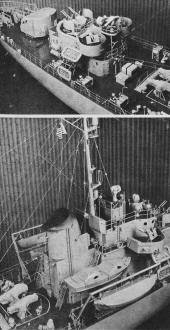
Professionally made model of Coast Guard Cutter "Owasco" is a
fine example of miniature boat builder's art. Many salaried model makers started
out at home as amateur enthusiasts.
New engines, fittings and construction materials certainly playa major role in
influencing increased model boat activity. O&R "Mariner," Atwood and Cameron
water-cooled engines permit enclosed cabins and superstructures to cover internal
combustion engines without a cooling problem. The engine exhaust is easily ducted
to the atmosphere.
Before the advent of these powerplants internal combustion engines could not
be operated in enclosed cabins without leaving all windows uncovered in order to
insure proper cooling. The windows also had to be extra large to guarantee a good
circulation of cool air through the cabin. These restrictions discouraged many potential
model boat builders. This is no longer true.
The Allyn outboard engine has afforded the builder a powerplant that could not
be more simple. Not only does this engine offer some realism for the outboard replica
but it also facilitates installation by eliminating shafting, universal joint, shaft
housing or stern tube, propeller and rudder. This is a real inducement to build
model boats.
New steam engines introduced by Allyson and the many electric motors available
such as Aristo, K&O and Pittman provide an unlimited selection of power for
the enthusiast.
In view of the fact that boats were invented before airplanes, obviously, model
boats preceded model airplanes. Although these had to float they did not require
the lightness of aircraft; therefore relatively hard woods that were easily obtainable
were used such as mahogany, pines and cypress. Despite the comparative workability
of this material it discouraged many who were not too adept at building. When balsa
wood made its appearance, primarily for model plane construction, a few boat builders
recognized its advantages and used it for their projects. Others continued with
the old materials and thereby maintained the barrier that discouraged the novice.
During recent years some kit manufacturers and magazine contributors have encouraged
the use of balsa for model boat construction with the result that many new enthusiasts
were attracted.
In the "old days" woods were sealed with flat house paint or not filled-in at
all! Consecutive applications of artist's oils were often used to color ship models.
This took many days to complete. Now, quick-drying model wood grain sealers and
colored airplane dope produce a fine, waterproof finish in a small fraction of the
time and effort. This and other time-saving products have helped to make model boating
popular.
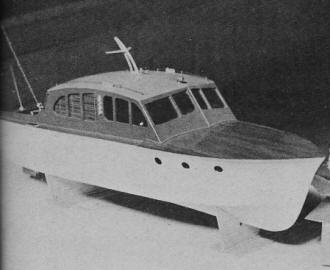
Almost 4' long, this big one is by Roy Donovan. Planked with
hard balsa, then fiberglassed. Shown in primer sanding stage. Water-jacketed O&R
.60 ignition engine. Swivel chair.
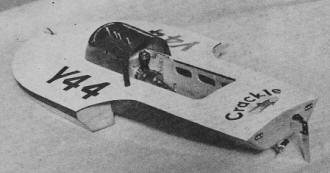
Exact scale of 48 cu. in. racing hydroplane uses Space Bug: travels
"at 30 mph." Hand-filled Hi Johnson prop. Built by "Hap" Ryan; fine finish, attention
to details make it outstanding.

Excellent feature about wall-built boat models is that properly
cared for they can last a lifetime. Here radio control has been added to 25-year-old
steam-powered cabin cruiser.

Over 40" of marvelous detail by Bill Price. Original design features
hand-made furnishings in each cabin. Power is Anderson Spitfire ignition with water-cooling
jacket.
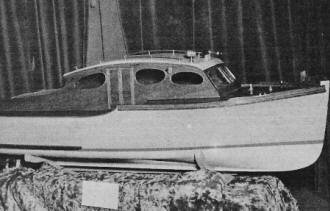
Mathews Cruiser with radio control is owned by Al Woods.
Solid hardwoods used throughout. Built, operated in San Francisco many years, now
in L.A. Home-built 4-cycle ignition engine.

Two by Les Garey, Left, R/C with under-water exhaust on re-worked
Allyn; balsa planked, then mahogany veneer covered. Hydroplane is exact scale model;
McCoy .09; mahogany and plastic.
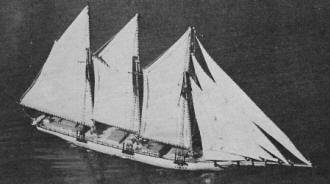
Three-masted schooner sailing across the boat pond is vision
of grace that few other models can equal. These craft are not overly difficult to
make, you just need lots of patience.
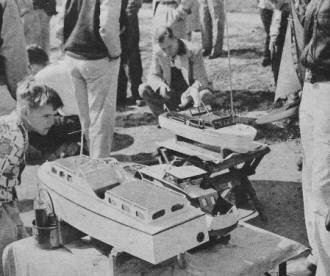
British Wavemaster kit job (foreqround) built by A. Chivorian,
and his Chris-Craft cruiser (center). Latter has complete bridge right down to fire
extinguishers, compass and controls.
Although they have been in existence for some time today's cast-metal deck fittings
seem to be more plentiful and better than ever, with much greater variety in size
and type. These castings save much time and effort in duplicating bitts and chocks,
life preservers, portholes, cleats, whistles, bells, life boats, davits, ladders,
stanchions, anchors, chain of all sizes, and hawse pipe all of which enhance the
appearance of scale ship models with a minimum effort on the part of the builder.
The examination-free Citizens Band for radio controlled models caused a sharp
increase in radio control activity and interest. Many rank novice operators installed
their sets in model planes as their initial radio venture. This was generally done
with very little or no model plane experience. The first slip in controlling and
down it comes! This is not meant to discourage the construction of model airplanes.
We merely wish to point out that radio controlling model planes requires some previous
knowledge of adjusting them whereas little is needed for model boats. It is obvious
that when the beginner installs his radio in a model boat any mistakes he makes
will not cause anything more serious than have his model run aground. Anyone can
radio control model boats.
Radio control participants seem to fall into two specific categories. The first
comprises the radio fan whose primary interest is in developing the controlling
device and who regards the model plane, car or boat as merely a vehicle to carry
the equipment and obey by performing precisely every command of the radio equipment.
The second group is made up of individuals who are interested in the model construction.
They build the model for the enjoyment of it and utilize the radio merely to enhance
the performance of their handiwork. The former group are apt to use multi-channel
and more complex equipment while the latter classification tends to install the
simplest radio set into the model in order to devote more time to the model and
less time to the radio.
The radio fan of "group one," therefore, wants to be able to operate as many
items on his vehicle as possible. Where will he find more items to operate than
on a model Destroyer, Landing Craft, or Cruiser, etc.? Rotating gun turrets, movable
ramps, weighing anchors and even firing torpedoes can be accomplished; not to mention
steering and engine control. Numerous radio control fans have turned to boats for
these reasons.
It has been said that model boats are for children. Toy boats of the five and
ten cent store variety, yes, but not model boats that require effort to construct
and intelligence to operate. The average age of the model boat enthusiast certainly
puts him above the kindergarten class. This fact is gradually being recognized and
many who were formerly "ashamed" to be associated with this "immature" activity
now are thoroughly absorbed in this enjoyable pastime.
Model boats never seem to die. We do not necessarily refer to the super-fast
racing craft which, because of their action packed existence, cannot withstand for
long the continuous abuse they are subjected to. But the average steam, electric
or internal combustion engine powered craft will last for at least a score of years
and more if properly maintained. We know of many models that are over twenty years
old.
As a matter of fact we have recently installed a radio controlling mechanism
in a steam powered boat that is over twenty-five years old and it looks and runs
like new! This is a tremendous incentive for meticulous model builders to build
their models carefully and add all of the painstaking detail they desire without
having to worry about their handiwork being dashed to pieces. This type of modeler
has looked towards scale boat modeling as an outlet for his talents.
Model boats can be carved very simply from wood blocks, made from layers of 1/2
to 1 inch planks of wood cut to the shape of the various decks and cemented together,
covered with sheet balsa or hardwood veneer over framing, or planking over framing.
Some hulls can even be made with sheet sides mounted on a heavy plank bottom. This
variety of techniques requires varied ability to construct models thereby inviting
both the veteran model airplane or car builder, and the novice who has never attempted
a model project before to try their hand at boats. Both beginner and expert will
be able to build and operate a boat model to suit their individual talents, taste
and pocketbook. The editors of "Young Men" magazine report astonishing response
to the model boat building and operating articles they have been running for more
than a year. When last June the cover illustration showed a model fishing boat of
the moss bunker fleet inquiries were received from all over the world concerning
availability of working drawings. As a result Frank Lashek and Cal Smith, both noted
modelers, were commissioned to turn out a replica. This has been scheduled for the
February and March 1956 issues of "Young Men" magazine. A good example of model
boat interest! -W. A. Musciano
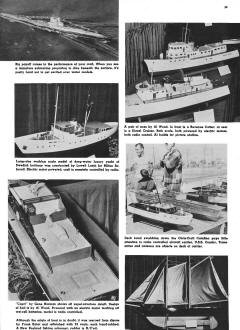
Big payoff comes in the performance of your craft. When you see
a miniature submarine preparing to dive beneath the surface, it's pretty hard not
to get excited over water models.
Large-size working scale model of deep-water luxury yacht of
Swedish heritage was constructed by Lowell Lamb for Milton Soboroff. Electric motor
powered, craft is remotely controlled by radio.
"Capri" by Gene Norman shows off super-structure detail. Design
of hull is by Al Wood. Powered with an electric motor working off wet-cell batteries,
model is radio controlled.
Although the origin of boat is in doubt. it was rescued from
disuse by Frank Kolar and refinished with 25 coats, each hand-rubbed. A New England
fishing schooner, rudder is R/C'ed.
A pair of aces by Al Wood. In front is a Revenue Cutter; at rear
is a Diesel Cruiser. Both scale, both powered by electric motors, both radio control.
Al builds for picture studios.
Deck hand swabbing down the Chris-Craft Catalina pays little
attention to radio controlled aircraft carrier, U.S.S. Condor. Transmitter and antenna
are objects on deck of carrier.
|



